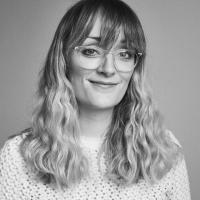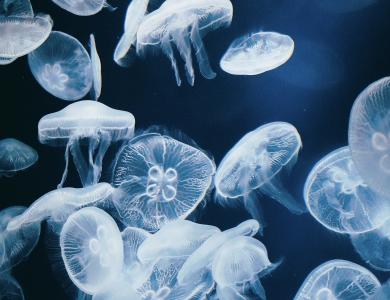
© Tania Franco Klein
Tania Franco Klein was awarded the Sony World Photography Awards National Award for Mexico in 2017 and her series Our Life in the Shadows was shortlisted in the 2018 edition of the Professional competition. Her work is highly influenced by her fascination with themes relating to social behavior, media overstimulation, emotional disconnection, obsession with eternal youth and the American Dream. Her work, which often takes on a surreal aesthetic, has garnered much attention from the art world and she has enjoyed a variety of successes in international art fairs. She shoots for FT Weekend, LA Times, i-D magazine and the Washington Post, amongst other prestigious titles.
You graduated in Architecture (BA) before undertaking a postgraduate degree in photography in London. How has architecture influenced your photographic practice?
I studied interior architecture and most of the sets for my photographs are situated in indoor spaces. My architectural practice has been crucial in the way that I conceive my work in all stages of the production process. For the latest stage, I support the work with its presentation and I conceive the exhibition as a single piece. I think my understanding of space and my past experience has truly allowed for that part of my practice to grow.
In all my exhibitions I try not to set any of the pieces at a functional height. Architecture allowed me to understand space, color and light from a unique perspective. I started developing my interest in photography at the same time as I was studying architecture, so it’s hard to imagine how I would create my work without all this background.
Was there one particular photographer or body of work that's made a big impression on your photographic practice?
There are a number of different artists I was introduced to (almost all at the same time) that have made a huge impression. I’m hugely inspired by Tony Oursler, Bill Viola, William Eggleston, Larry Sultan, Todd Hido and Pipilotti Rist.
To what extent is your work autobiographical?
My work is autobiographical in the sense that I conceive the work as a reflection of today's society. My photographic projects are usually motivated by personal interest or existential observations of my place in today's world. I try to translate those personal emotions into something universal because it is hard to separate the individual from the context nowadays. I hope my work invites viewers to reflect about topics we can all relate to in today's world while exploring my own role in this worldwide social machine.
There’s always a warm glow to your photographs. What do you find so appealing about working with such an intense colour palette?
I have always had a very personal connection to intense colors as they generate a very strong emotional response. Colours have a language of their own. In terms of how I think of colour in my practice, I would say that my scenes usually involve characters, or their shadow, in a very still, quiet – almost anonymous – way. My stories are quite emotional and I think the way I use colour and light really sets the emotions towards a deeper level in the viewer’s eyes. I like to think of colour as a piece of music that could sometimes be very loud.
As many of your photographs are self-portraits, could you tell us more about the process behind your series? How do you stage your portraits?
I try not to have a method in the way that I make my photographs. Sometimes that means making sets from scratch or around a wall that I find. In the process of constructing the scene of the photograph, I am sometimes not sure if I will actually have a subject. I experiment a lot and allow my work to be quite performative, so I set up a scene and play around with it for a long time. I like discovering throughout the process what will happen and I usually work alone. I set up a tripod and use a remote trigger release, experimenting with the scene as much as I can.
You have a healthy Instagram following. Has this platform taught you anything about your work?
Of course, I see Instagram as a great tool to be able to curate my work and share the process of my projects. I still get surprised by the number of opportunities that come out by being active on this platform. That being said, I try not to judge my own work in terms of likes. We also have to be very cautious of how we feed on the things we see to be able to use Instagram in a productive manner, instead of comparing ourselves to others. I would experiment a lot with the stories feature. I have actually gone back and re-worked something that started as an experimental play for my Instagram which has actually then led to making a piece.
What do you think is the most exciting trend in the photography world right now? And how do you see the medium evolving?
I am not very keen on trends actually. I usually get tired when I realise a lot of people are doing the same thing over and over. I am an advocate for diversity in all senses of the word and I very much enjoy seeing polar universes meeting in an artist's work. That being said, I think photography has reached a point where we overproduce photographs and as a result, I sometimes cannot get my head around my work.
Your family is a great source of inspiration for you. Could you tell us more about what it means to be working with close members of your family?
I have been quite reluctant to work with unfamiliar subjects because that meant for me that I also needed to somehow deal with their expectations and their representation of themselves. My characters are usually quite anonymous, they are placeholders for all of us. It is not really about the person in the image but what that person stands for and what they represent. For that reason being able to work with my family and specifically with my recently passed grandmother allowed me to create with them a more flexible environment where their collaboration came from a place of understanding and wanting to help. Of course in the process being able to share and play and perform with them became a treasure for me.
Your series Our Life In The Shadows was shortlisted in the Sony World Photography Awards Professional Competition in 2018. How has this recognition helped your career? Has it made a positive impact?
Of course, I think any source of recognition is always good for the work. I don't think there is one event — call it an award, review, or exhibition, —that will make a project stand alone but I do believe a combination of events is always helpful. In this project in particular I was quite lucky because one year I submitted a single image to the Open competition and got the chance to travel to London. Seeing the work exhibited at the Somerset House gave me a lot of inspiration to keep going, and the next year when the project was more evolved I decided to submit it as a series and got selected again.
One thing always leads to the other, so I also got a chance to show the work in different printed magazines that I admire and to exhibit it with galleries at fairs. It is always nice to have your work recognizsd by such great platforms like the Sony World Photography Awards, and in the end, I guess what we all want when we do a project is to be able to have it out there, exposed in the world and using all the amazing platforms that exist today.
Enjoy Tania's takeover
Follow Tania's Instagram
View Tania's portfolio



